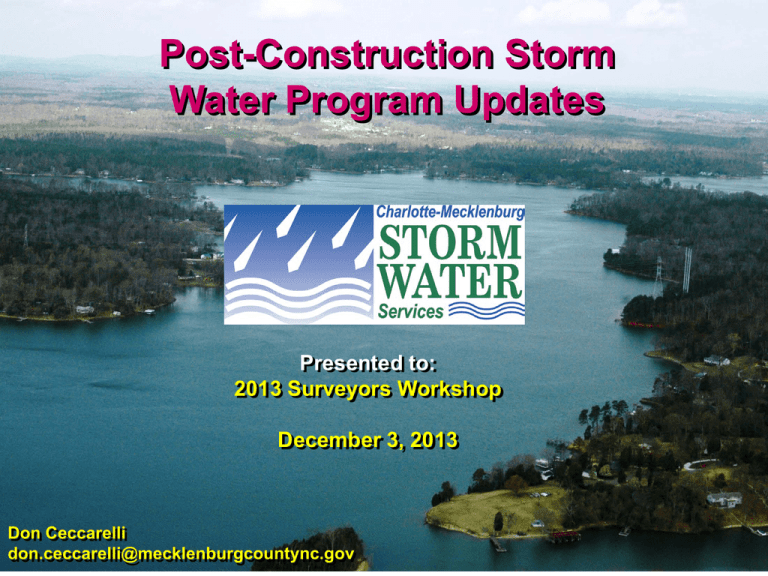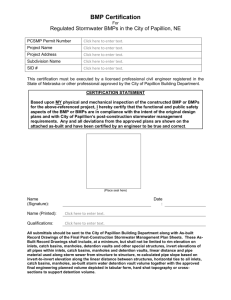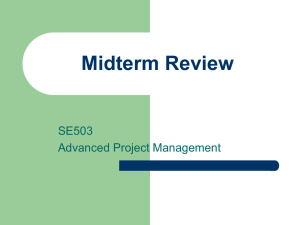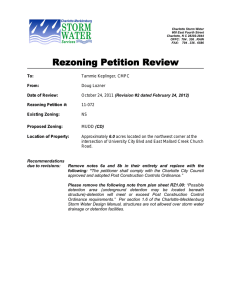Post-Construction Storm Water Program Updates Presented to: 2013 Surveyors Workshop
advertisement

Post-Construction Storm Water Program Updates Presented to: 2013 Surveyors Workshop December 3, 2013 Don Ceccarelli don.ceccarelli@mecklenburgcountync.gov Post Construction Program 1. Post Construction Overview 2. Changes in BMP Design Manual 3. Changes in Administrative Manual 4. Buffers Everywhere Storm Water Trivia Annual rainfall in Charlotte = 43 inches Annual rainfall in Mt. Waialeale = 39 feet Mt. Waialeale in Kauai, HI Post-Construction Ordinance Goals 1. Achieve compliance with Storm Water Permit requirements. 2. Satisfactorily address the pollution control criteria recommended by Wildlife agencies. 3. Satisfactorily address the causes of water quality impairment. 4. Satisfactorily address detention measures for the control of flooding. WARNING There are 8 postconstruction ordinances within Mecklenburg County. NO two ordinances are the same. Post-Construction Ordinance Standards 1. Structural BMPs 2. Buffers 3. Detention 4. Open Space Requirements for Post-Construction Ordinance Watershed Districts Yadkin District CENTRAL CATAWBA WESTERN CATAWBA BMPs CATAWBA >10% BUA @ 85% TSS YADKIN-SOUTHEAST & 70%TP removal GOOSE CREEK HUNTERSVILLE * >12% in Mint Hill Western Catawba District BMPs N LAKE >12% BUA @ 85% NORMAN TSS & 70%TP removal * >24% in Cornelius UPPER MTN ISLAND Buffers Same as Central Catawba District Detention Same as Central Catawba District LOWER Open Space Same as Central Catawba District CLARKE McDOWELL MALLARD LONG Huntersville BMPs >24% BUA @ 85% TSS BEAVERDAM removal Buffers S.W.I.M. + 30 ft on int. streams Detention LAKE WYLIE V = post 1-yr, 24-hr storm; P = 10-yr & 25-yr, 6-hr Open Space <24% BUA = 25%; >24% BUA = 17.5%; >50 BUA = 10% <50 ac.= 50 ft.; >50 ac. = 100 ft Detention Same as Central Catawba District Open Space Same as Central Catawba District BACK >12% BUA @ 85% TSS McKEE IRWIN & LID BMPs REEDY BMPs CALDWELL * >6% in MI Critical Area PAW Central Catawba District BMPs LOWER CLARKE Buffers GAR MTN ISLAND CATAWBA ROCKY RIVER Buffers UPPER BRIAR LITTLE Same as Central SUGAR Catawba District Goose Creek District CLEAR Buffers SUGAR Detention STEELE GOOSE V = pre–post 1-yr, or 2-yr McALPINE 24-hr based on zoning McMULLEN Detention LOWER P (> 12% BUA) = 2-yr & LITTLE 10-yr, 24-hr CROOKED FOUR MILE SUGAR Open Space None TWELVE MILE Open Space SIX MILE CLEM 5 5 Exceeds current State0requirements 10 Miles Any BUA @ 85% TSS (pre-post, 1-yr, 24-hr) S.W.I.M + 100-ft on streams; 200-ft on streams w/floodplain V = pre–post 1-yr, 24-hr P = 10-yr & 25-yr, 6-hr <20% BUA = 0%; >20% BUA = 15%; >50 BUA = 10% Key Factors for Post Construction Ordinance Applicability: • • • • • • Date of Activity – some “grandfathering” of activities based upon submittal date (not approval date) Vested Right – some activities exempt if vested rights established Conditional Zoning District – some activities deferred from complying Type of Development – Industrial/Commercial/Residential, new development or redevelopment Size of Disturbance – some exemptions based upon the amount of disturbed area Increase of BUA – some exemptions allowed if no net increase in BUA and no decrease in storm water control Post-Construction Requirement Applicability: • BUFFERS – Except in Goose Creek, post-construction buffers only apply if the post-construction ordinance applies • WQ BMPs– Except in Goose Creek, BMPs are required if BUA percentage is greater than Threshold Amount • DETENTION – Detention is required if BUA percentage is greater than Threshold Amount (or if detention policy applies) • UNDISTURBED OPEN SPACE– Required for development only, not redevelopment BMP Design Manual Updates http://charmeck.org/stormwater/regulations/Pages/BMPStandardsManual.aspx BMP Design Manual Updates (July 2013) • • • • • • • • 3.0 Hydrology Alternative methodology for 5% volume remaining Water balance calculations modified to account for rainfall discharged through outlet structures 4.1 Bioretention New sizing criteria similar to NCDWQ Allowance for IWS and infiltration Allowance for sodded bioretention Requirement for watertight seal of pipe to outlet structure BMP Design Manual Updates (July 2013) • • • • • • • • 4.2 Wet Ponds Minimum drainage area increased to 25 acres with addition requirements (permeability tests, etc.) Allowance for use of floating islands and irrigation. Requirement for watertight seals of pipes and outlet structures. Forebay embankment detail updated to include riprap armoring. 4.3 Wetlands Requirement for watertight seals of pipes and outlet structures. Require the permanent pool near the water table. BMP Design Manual Updates (July 2013) • • • • • • • • • • 4.4 Enhanced Swales Allowance for IWS and infiltration. 4.6 Infiltration Trench Allowance for infiltration in hydraulic calculations. 4.8 Sand Filters Allowance for IWS, void space, and infiltration. Allowance of sod or stone surface cover. Provided a design standard for optional oversized basin for additional storage. 4.9 Dry Detention Added standards for underground detention structures BMP Design Manual Updates (July 2013) • • • • • • • • 4.10 Permeable Pavement Allowance for BUA credit similar to NCDWQ with the exception of Watershed caps. (May require ordinance changes to implement). 4.10 Green Roofs Revised minimum depth of media from 5 to 4 inches. 4.10 Storm Water Harvesting Allowance for storm water harvesting systems. 5.5 Outlet Pipes / Level Spreaders Added language and design standards to define “diffuse flow” to prevent erosion within buffers. 2013 Administrative Manual Updates http://charmeck.org/stormwater/regulations/Pages/PostConstructionAdminManualCountyTowns.aspx Administrative Manual Updates (2013) • • • • • • BMP Maintenance Covenant & Plan Combined Covenant and Maintenance Plan into one document. Same Covenant for Owner and HOA. Escrow accumulation periods changed. Maintenance Cost Estimation spreadsheet revised. Post-Construction Certification • Design Engineer required to certify that construction, as-built surveys, recorded plats, and field conditions are in compliance with the approved designs, plans, and the PostConstruction ordinance Administrative Manual Updates (2013) • Detention and Peak Control • Section 2.5.3 was revised to clarify interaction of detention ordinance with Post-Construction ordinance. • Mint Hill eliminated detention requirements for non-Post-Construction projects. • Matthews changed Detention Ordinance grandfathering date to July 10, 2000. • Significant Changes to Grandfathered Plans • Language added to clarify changes to previously grandfathered developments that could trigger post-construction applicability. Administrative Manual Updates (2013) • • Recorded Plats • Built-upon area maximums are required to be listed for each lot subject to the Post-Construction ordinance. Ordinance Changes • Town of Cornelius changed high density BUA threshold from 12% to 24% BUA. • Town of Huntersville changed high density BUA threshold from 6% to 15% BUA, adds LID mitigation options, and allows “qualified professionals” to perform annual BMP inspections. Water Quality Buffers ftp://ftp1.co.mecklenburg.nc.us/WaterQuality/WQ%20Buffer s/WaterQualityBufferImplementationGuidelines.pdf How are Buffers Measured Types OfOfWater QualityBuffers Buffers Types Water Quality 1. Water Supply Watershed Buffer: 1995 through 1998. 2. Surface Water Improvement & Management (SWIM Buffer): 1999 through 2000 3. Catawba River Buffer Rules: 2001 4. Post-Construction Buffer: 2007 through 2008 5. Goose Creek Buffers – February 2009 Buffer Ordinances • Watershed – Lake Norman 1. Davidson 2. Cornelius 3. Huntersville – MI Lake 4. Cornelius 5. Char-Meck 6. Huntersville – Lake Wylie 7. Char-Meck – Upper 8. Char-Meck - Lower • SWIM 9. 10. 11. 12. 13. 14. 15. 16. Charlotte Cornelius Davidson Huntersville Matthews Mecklenburg County Mint Hill Pineville Buffer Ordinances • Post-Construction 17. Charlotte 18. Cornelius 19. Davidson 20. Huntersville 21. Matthews 22. Mecklenburg County 23. Mint Hill 24. Pineville • Catawba River 25. NCDWQ Riparian How To Determine The Buffer That Applies • Review the applicability sections of the ordinances. • If more than one buffer applies to the same parcel, the more stringent will govern. Information to Gather • • • • • • Buffer Types Existing location of buildings Existing condition of buffers Date the lot was platted Date the building was constructed Future Plans of Owner…. Expansion? Clearing?....Pool?.....Gazebo? • SWIM Buffers Quick Tips – Existing platted lots are not subject – Contains multiple “zones” within buffer with different restrictions for each zone. • Watershed Buffers – Existing Lots are generally subject – Existing Development are generally not subject • Post-Construction Buffers – Buffers apply if the post-construction ordinance applies (which is typically if greater than 0.5 acres is disturbed) – Contains multiple “zones” within buffer with different restrictions for each zone – Six Mile Creek and Goose Creek buffers apply as of 2009 • All planned additions, expansions, and grading must be evaluated individually and cumulatively Case Study Case Study Case Study Planned Expansion: -0.6 acre site -disturbs 5,000 ft2 - Adds 4,000 ft2 Case Study Planned Expansion: -0.6 acre site -disturbs 5,000 ft2 - Adds 4,000 ft2 Questions?


